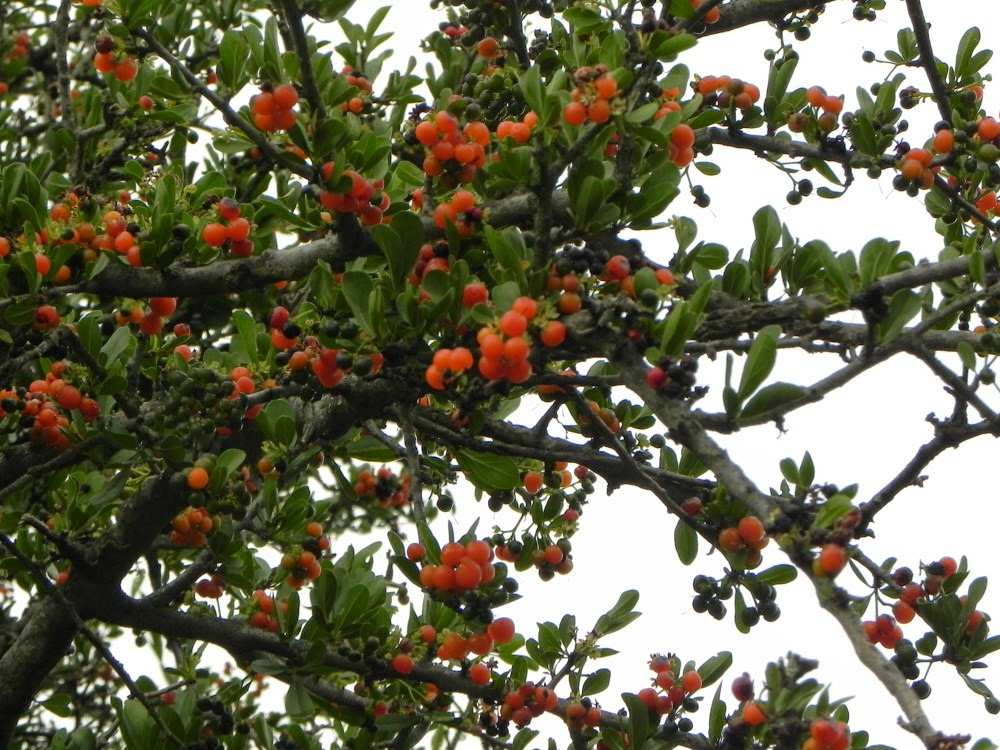 |
| a view from above overlooking parts of Rookwood in the summer |
Summer
time is always a very rewarding time with many wonderful sights and sounds that
surround us. Depending on the seasonal rains, the veldt comes alive with many
different flowers and fruits.
 |
| a pair of Greater Striped swallows |
This year the rains have been reasonably good
and the veldt has grown well. From the time we hear the very characteristic
call of the Black Cuckoo singing its’ mournful tune of “I’m so sick” or maybe
“Time to plough,” we know that possibly the rains are imminent. With the rains
the mud is produced for the Greater Striped Swallows, who work very hard at
producing their rather precarious type mud houses to be able to nest.
 |
| the tiny heads of the African Paradise Flycatcher in their web-bound nest |
The
apricot tree outside the kitchen is now fully leafed – enough for the African
Paradise Flycatchers to build their tiny little nest bound with spider webs in
the branches.
 |
| the tall Maermanne!!! |
While the birds are busy nesting, the plants and
trees at Rookwood start flowering. One of the plant species that start early
summer is that of the Maerman (Urginea
altissima). This strange looking plant sends out a long flower that is
extremely tall. The bulb and leaves are toxic to all stock and the cattle and
sheep do not eat it at all. However, during the winter months they readily eat
the dried leaves. Not a very attractive plant, but very conspicuous due to its
height.
At
about the same time another bush often bursts into purple flowers all over. This
bush is commonly called a Puzzle Bush or Cape Lilac, but is known as an Ehretia rigida. It then produces fleshy
orange fruit, which the Barbets particularly love (Pied and Black-collared).
 |
| Brides bush in flower |
One
particular small tree/bush that has very pretty flowers is the Brides bush (Pavetta species). There are not many on
Rookwood, but when they are in full flower, they truly stand out from a
distance. Apparently the roots can be used for rheumatism.
By
the middle of December the Acacia karroo
is full in flower with yellow flowers. This is the main representative of the
savannas of the Eastern Cape. These small round flower heads will later turn
into pods that are highly nutritious for livestock and game and sought after by
all animals. No wonder it is called Sweet thorn. Although it is commonly used
as firewood for braaing (barbecuing), it can produce some very pretty
furniture.
 |
| Acacia karroo or sweet thorn in full bloom |
By
the middle of summer the Common poison bush (Acokanthera oppositifolia) has produced its’ seed. Many of these
bushes can be found on all the ridges of Rookwood. There are truly some magnificent
specimens on Rookwood. This plant is highly toxic and even grilling some meat
on the fire made with the wood of this bush can be fatal. The bark and wood were
used to make a very potent arrow poison and the only part of the plant that is
edible, is that of the ripe fruit.
Depending
on the rains the alien Agave or sisal will produce a wonderful show of yellow
flowers. These flowers are a hive of activity with many different bird species
either feeding off the nectar or the insects present. They will flower for
almost a month before they die and the whole ‘shoot’ then dies off. Many people
use this dried up part for a South African Christmas tree. The plant was
introduced into South Africa from South America and can be utilized as fodder
during the dry periods when the leaves are sliced into pieces, particularly for
the cattle. This is also the plant that the famous alcoholic drink (tequila) can
be made from.
 | |||
| the flowers of the sisal plant being uitilized by the bees |
Not every summer is the same at Rookwood and the
amount of rainfall will be reflected in the growth of the veldt, however, it is
always rewarding to take a walk down the river or up the hill on the farm.
As
the direct rays of the sun turns and starts retreating towards the equator, the
domestic stock and all other animals make maximum use of the summer season to
breed, feed and stock up for the winter months.
 |
| young lambs observing a Glossy starling looking for insects |
We
are truly blessed to live in such a diverse country and I am always saddened at
how few of our own indigenous plants (trees and bushes) are actually planted in
cultivated gardens. I am fortunate to live with one very big indigenous garden!
 |
| a tranquil summer scene at the dam at Rookwood |







